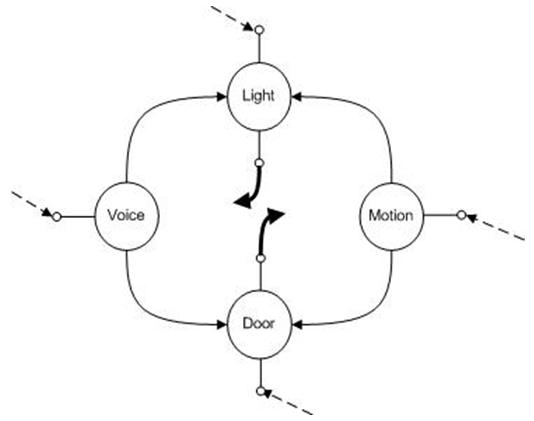|
Developing Home Automation Wireless Sensor Networks with ASSL
|

|
|
|
|
|
Home automation (also called domotics) is about integrating a computerized
control system at home. Being an intelligent network of electronic devices, such a system
is usually designed to monitor and control the home-integrated mechanical and lighting systems.
Thus, domotics helps to construct the so-called smart homes, where the application of automation
techniques helps for the comfort and security of the home residents. Some important aspects of
home automation are light and climate control, control of doors and window shutters, security
and surveillance systems, and control of multi-media home entertainment systems. Another form
of home automation is the so-called assistive domotics, which focuses on making it possible for
elderly and disabled persons to live in safe and comfortable homes. This form of home automation
helps such persons by providing them with many different types of emergency assistance systems,
security features, fall prevention, automated timers, and alerts. Moreover, it helps family
members to monitor their loved ones from anywhere via internet connection.
From a technical perspective, a domotics system needs a computing infrastructure
providing a composition of controllers, sensors, and actuators. Here,
controllers decide how the system should react to environmental changes detected by sensors and
actuators are responsible for acting on system’s parts upon requests from controllers.
|
|
|
|
With this project, we aim at research and development of home automation wireless sensor networks
(HAWSNs). In our approach, a HAWSN is considered to be an autonomic system (AS) employing self-management
by virtue of special policies driving the network in question. We rely on ASSL (Autonomic System
Specification Language) to model and validate formally, and generate the implementation of prototype
models for HAWSNs. Note that the possibility to formally validate HAWSNs is a considerable advantage,
because HAWSNs may be considered as critical systems where design or implementation flaws might be
extremely expensive and even turn into hazards. With ASSL we develop prototypes where the needed
sensors are generated as software stubs used to simulate runtime sensing of environment. Here, no
expensive hardware is employed until the deployment of a HAWSN prototype. Thus, the proposed approach
helps developers decrease the development time and cost and increase the quality of the targeted HAWSN.
This is possible, because design and implementation flaws can be discovered and changes can be made
while they are still inexpensive, i.e., sensors and actuators have not been put in place and the HAWSN
in question has not been deployed yet. Moreover, with this approach we can generate a series of prototypes
to explore different aspects of a HAWSN by evaluating those prototypes under simulated conditions.
Finally, any successful prototype model may be transformed into a real HAWSN by employing hardware
attached to the control software generated by the ASSL framework.
|
|
|
|
We develop a simple HAWSN model for a living room. With this model, we target lightening and door
automation via voice commands, light sensors, and motion detection. With ASSL we specify intelligent
network sensors as AEs(autonomic elements), i.e., we specify four distinct AEs composing the targeted
HAWSN. Those AEs embed managed elements that allow the former to sense the environment, act, and
communicate wirelessly. The following elements represent the four AEs:
 |
This figure depicts the data-control flow process in the prototyped HAWSN. As shown, each of the AEs
inputs data in the system via specific sensors (cf. the dashed arrows). Next, AEs process that data locally
and react by sending messages to other AEs (cf. the thin arrows) or by acting in the home environment via
its actuators (cf. the bolted arrows). The Voice AE sends messages in the form of voice commands to both
Light and Door AEs and the Motion AE sends messages in the form of relative coordinates of moving objects.
Thus, both messages exchanged among AEs and data coming through sensors make AEs acting.
|
-
Light AE - controls the lights in the living room. This AE uses light sensors to determine the
level of brightness in the living room and uses a light switcher actuator to turn on/off the lights.
Moreover, this AE communicates with the Motion AE to determine when and where there is motion in the
room, which could prompt turning lights on.
-
Voice AE - controls microphones installed in the living room. This AE process input from the
microphones to detect and recognize voice commands. It communicates with the Light AE and with the Door
AE, which act on voice commands, such as “turn lights on/off” or “open/close door”.
-
Motion AE - controls motion detectors to sense motion in the living room. It zones the living
room and detects where the motion is taking place. This AE communicates with the Door AE and with the
Light AE.
-
Door AE - controls a door actuator to open or close the living room door. It also senses the
area near the door for obstacles and communicates with the Voice AE and the Motion AE, e.g., when motion
is detected towards door, the Door AE opens the door automatically.
A partial specification model for HAWSN developed in the course of this project can be downloaded here:
»
ASSL Specification
|
|
|